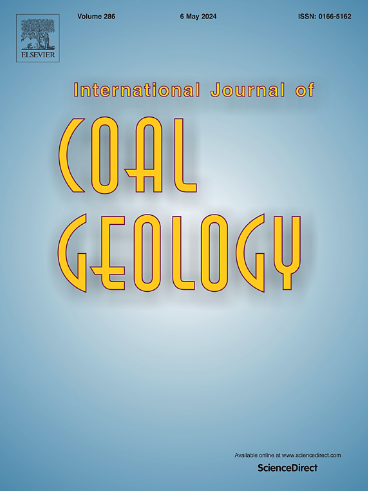基于clsm的显微光谱法表征含油气流体包裹体,并应用于德国Gorleben和Morsleben地区的上二叠统岩盐
IF 5.7
2区 工程技术
Q2 ENERGY & FUELS
引用次数: 0
摘要
采用共聚焦激光扫描显微镜(CLSM)、入射光和透射光荧光显微镜相结合的方法,对德国Gorleben和Morsleben地区的岩石层、Gorleben地区的石油和环氧树脂中的含油气流体包裹体(HCFI)进行了原位分析。HCFI包含蒸汽相和液态烃相,它们的光学外观变化广泛而独特。基于405 nm的激发允许原位clsm相关采集和区分两个位点的HCFI发射光谱。与采用阻挡滤光片>;515 nm的透射光显微镜相比,clsm相关发射>;410 nm采用了观测HCFI全发射光谱所必需的全发射光谱。HCFI在Gorleben位点的最大发射强度λmax为455 ~ 456nm,而在Morsleben位点的最大发射强度λmax为485 ~ 495nm,说明与Morsleben位点相比,Gorleben位点的HCFI发射光谱发生了“蓝移”。这意味着蓝移是由于在Gorleben位点上HCFI向芳香/极性较少的组成转移引起的。HCFI和石油的光谱性质与环氧树脂有明显的不同,这表明在检查的厚切片中没有环氧树脂的污染。根据红绿系数(Qmax)和经验相关方程以及直接测量的API值,对API(石油液体密度的标准)进行粗略近似,结果表明,具有较高API值的Gorleben和Morsleben地区的API重力存在显著差异,第一个API值高达52.4。综上所述,本研究结果证明了CLSM作为一种先进的获取盐岩中HCFI原位光谱特性的方法的适用性和适应性,可作为了解沉积环境中油气生成和运移的基础。本文章由计算机程序翻译,如有差异,请以英文原文为准。
Characterizing hydrocarbon-bearing fluid inclusions using CLSM-based microspectrometry with application to the Upper Permian rock salt in the Gorleben and Morsleben sites, Germany
Hydrocarbon-bearing fluid inclusions (HCFI) in halite from the Gorleben and Morsleben sites (Germany), petroleum from Gorleben, and epoxy resins have been analysed in-situ using a combined approach of confocal laser-scanning microscopy (CLSM), incident light, and transmitted light fluorescence microscopy. The HCFI contain vapour and liquid hydrocarbon phases and their optical appearance varies widely and distinctively. 405 nm based excitation allowed for in-situ CLSM-associated acquisitions and distinction of HCFI emission spectra for both sites. In contrast to transmitted light microscopy equipped with barrier filter >515 nm, the CLSM-related emission >410 nm employed full emission spectra essential for observation of the entire emission spectrum of HCFI. While maximum emission intensity (λmax) of HCFI at the Gorleben site peaks at 455–456 nm, the corresponding λmax at the Morsleben site ranges from 485 to 495 nm, indicating that emission spectra of HCFI at Gorleben site are “blue-shifted” in comparison to those at Morsleben. It is implied that the blue-shift is caused by a shift to a less aromatic/polar composition of the HCFI at Gorleben site. Both, HCFI and petroleum differ noticeably in spectral properties from epoxy resins indicating no contamination of epoxy resin in the examined thick sections. Coarse approximations of °API (a standard for petroleum liquid density), based on red/green coefficient (Qmax) and empirical correlation equation as well as direct measurements of °API, suggested markedly different °API gravities for Gorleben and Morsleben sites with higher °API values, of up to 52.4 for the first. Collectively, the results of this research study demonstrated the applicability and adaptability of CLSM as a well-advanced method to acquire in-situ spectral properties of HCFI in salt rock, as a basis for understanding hydrocarbon generation and migration in sedimentary environments.
求助全文
通过发布文献求助,成功后即可免费获取论文全文。
去求助
来源期刊

International Journal of Coal Geology
工程技术-地球科学综合
CiteScore
11.00
自引率
14.30%
发文量
145
审稿时长
38 days
期刊介绍:
The International Journal of Coal Geology deals with fundamental and applied aspects of the geology and petrology of coal, oil/gas source rocks and shale gas resources. The journal aims to advance the exploration, exploitation and utilization of these resources, and to stimulate environmental awareness as well as advancement of engineering for effective resource management.
 求助内容:
求助内容: 应助结果提醒方式:
应助结果提醒方式:


